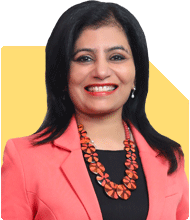Ramalingam Kalirajan |8077 Answers |Ask -Follow
Mutual Funds, Financial Planning Expert - Answered on May 07, 2024
He has an MBA in finance from the University of Madras and is a certified financial planner.
He is the director and chief financial planner at Holistic Investment, a Chennai-based firm that offers financial planning and wealth management advice.... more

I am earning Rs. 126000. My age is 48. I have home loan paying 75000 per month. How much and where should I invest to get 1 lakh per month
Increase Income Streams:
Consider exploring opportunities to increase your income through additional sources such as freelance work, consulting, or starting a side business.
Increasing your income can provide additional funds for investment and help you achieve your target more quickly.
Reduce Debt Burden:
Since a significant portion of your income goes towards servicing your home loan, consider strategies to accelerate your loan repayment.
Making extra principal payments or refinancing your loan to lower interest rates can help you pay off the loan faster and free up funds for investment.
Invest Wisely:
Allocate a portion of your remaining income towards high-return investment vehicles such as mutual funds, stocks, or real estate investment trusts (REITs).
Diversify your investment portfolio across different asset classes to spread risk and maximize returns over the long term.
Retirement Planning:
Given your age, it's crucial to prioritize retirement planning to ensure financial security in your later years.
Consider investing in retirement-focused instruments such as Employee Provident Fund (EPF), Public Provident Fund (PPF), or National Pension System (NPS) to build a retirement corpus.
Consult a Certified Financial Planner:
Seeking guidance from a Certified Financial Planner can provide personalized advice tailored to your financial situation and goals.
A professional can help create a comprehensive financial plan that aligns with your objectives and helps you achieve your target income.
Patience and Discipline:
Building a passive income stream of 1 lakh per month requires patience, discipline, and a long-term investment mindset.
Stay focused on your goal, monitor your progress regularly, and adjust your investment strategy as needed to stay on track.
Remember that achieving a passive income of 1 lakh per month may take time and dedication, but with careful planning and strategic investment, it's definitely achievable. Keep a positive mindset, stay committed to your financial goals, and seek professional guidance to maximize your chances of success.
You may like to see similar questions and answers below
Sunil Lala | Answer |Ask -Follow
Financial Planner - Answered on Jan 19, 2024
Ramalingam Kalirajan |8077 Answers |Ask -Follow
Mutual Funds, Financial Planning Expert - Answered on May 18, 2024
Ramalingam Kalirajan |8077 Answers |Ask -Follow
Mutual Funds, Financial Planning Expert - Answered on Aug 03, 2024
Ramalingam Kalirajan |8077 Answers |Ask -Follow
Mutual Funds, Financial Planning Expert - Answered on Oct 03, 2024
Archana Deshpande |103 Answers |Ask -Follow
Image Coach, Soft Skills Trainer - Answered on Mar 05, 2025
Archana Deshpande |103 Answers |Ask -Follow
Image Coach, Soft Skills Trainer - Answered on Mar 04, 2025
Archana Deshpande |103 Answers |Ask -Follow
Image Coach, Soft Skills Trainer - Answered on Mar 04, 2025
Dr Dipankar Dutta |909 Answers |Ask -Follow
Tech Careers and Skill Development Expert - Answered on Mar 04, 2025
Dr Dipankar Dutta |909 Answers |Ask -Follow
Tech Careers and Skill Development Expert - Answered on Mar 04, 2025
Dr Dipankar Dutta |909 Answers |Ask -Follow
Tech Careers and Skill Development Expert - Answered on Mar 04, 2025
Dr Dipankar Dutta |909 Answers |Ask -Follow
Tech Careers and Skill Development Expert - Answered on Mar 04, 2025
Dr Dipankar Dutta |909 Answers |Ask -Follow
Tech Careers and Skill Development Expert - Answered on Mar 04, 2025
Prof Suvasish Mukhopadhyay |458 Answers |Ask -Follow
Career Counsellor - Answered on Mar 04, 2025
Prof Suvasish Mukhopadhyay |458 Answers |Ask -Follow
Career Counsellor - Answered on Mar 04, 2025




















